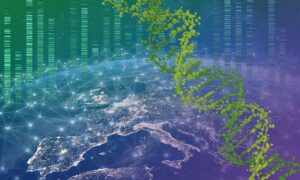
Kristina Haase from EMBL Barcelona receives ERC Starting Grant
The Group Leader will receive €1.5 million over the next five years to develop her project on 3D vascularised in vitro cardiac tissues

Kristina Haase and her group study microvessels, one of the first organs to develop in an embryo. These constitute the smallest diameter blood vessels which make up a vast network in the human body and are responsible for the exchange of oxygen, nutrients, and immune cells. A dysfunction in this complex network can lead to organ malfunction and disease development. Dr Haase and her group replicate microvasculature – the system of tiny blood vessels – in the laboratory to understand vascular disorders, such as placental-associated pre-eclampsia, and gender-linked endocrine and genetic differences, such as those commonly seen in breast cancer.
The ERC Starting Grant will secure funding for Dr Haase’s project ‘3D vascularised cardiac models to investigate Coronary Microvascular Disease (3DVasCMD)’. Taking her group in a new direction, Dr Haase plans to study coronary microvascular disease (CMD), which contributes to ischemic heart disease, the number one cause for human mortality globally. To do so, the team will use stem cells to build a 3D model representing major components of the human heart including beating myocyte tissue and functional blood vessels. This model will be used to understand how several risk factors, including ischemia, diabetes, and sex-specific hormones, contribute to coronary microvessel dysfunction.
“We aim to develop a high-throughput system with precise fluidic control to study our unique human vascularised cardiac models, which will be a breakthrough technology for drug safety and development,” said Dr Haase.
The group’s expertise lies in building vascular models in microfluidic chips. These chips are millimetre-scale devices made from a flexible polymer with several modifiable channels that allow for inclusion of a cell-containing hydrogel region and adjacent media reservoirs. Researchers can supply various fluids or molecules of interest into the channels, which connect to the embedded microvessels, to analyse vascular development. For the 3DVasCMD project, Dr Haase’s team will develop heart-specific vessels that integrate with cardiac organoids to investigate the crosstalk between microvessels and cardiomyocytes.
Dr Haase’s model will represent a paradigm shift for the biopharmaceutical and medical fields, allowing for simultaneous monitoring of therapeutic effects on two tightly connected tissues – the myocardium (heart muscle) and the microvessels. In addition, the team plans to combine the model with machine learning, which would allow them to conduct predictive cardiovascular patient-specific drug screens.
To achieve these ambitious aims, the group will continue pursuing interdisciplinary research. Haase plans to recruit a PhD student and two postdocs with biology and engineering backgrounds to execute this project. The team will also work closely with Dr Jaroslaw Sochacki, iPSC Specialist at EMBL Barcelona, and the tissue engineering facility at the Center for Genomic Regulation (CRG) to develop the cardiac tissues. For investigating metabolomics and machine learning, Haase and her group will work with Dr Theodore Alexandrov from EMBL Heidelberg and Dr Virginie Uhlman from EMBL-EBI, thus furthering interdisciplinary research across EMBL sites.


